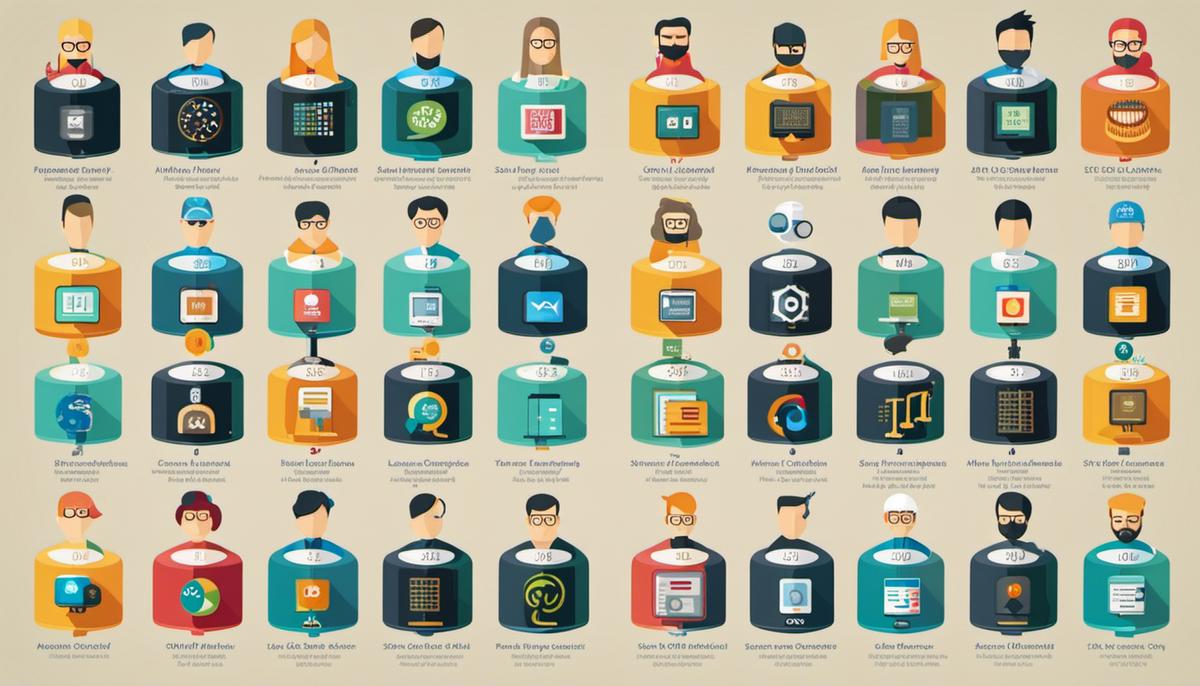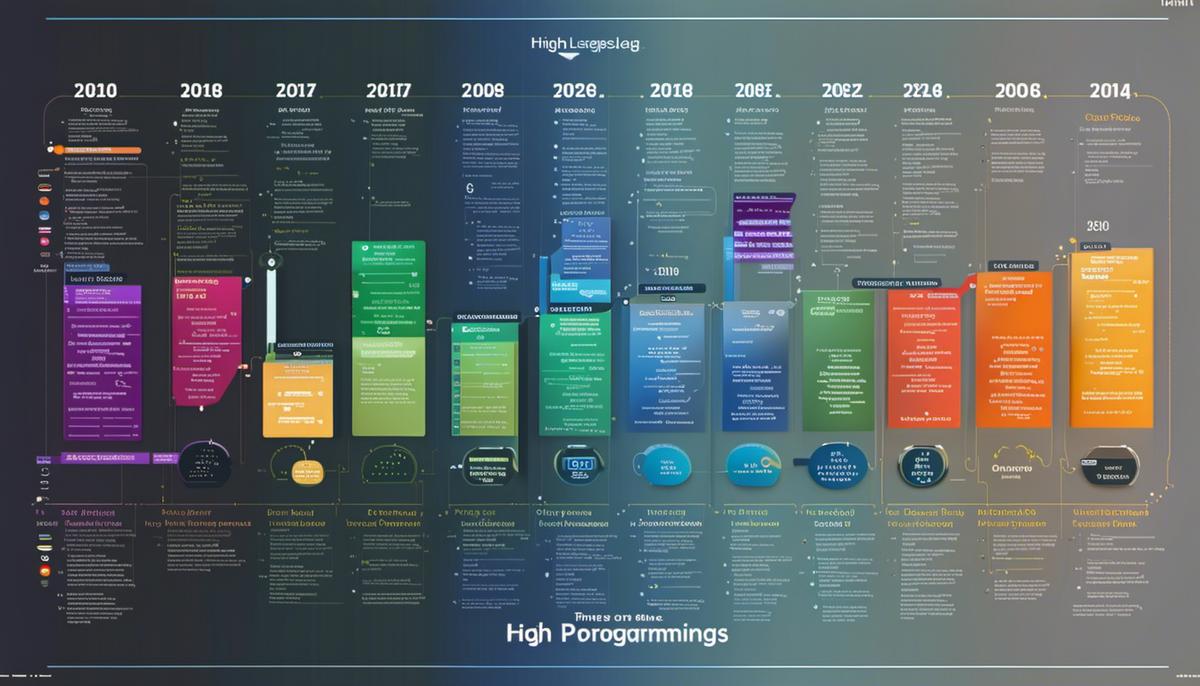Imagining a world without the convenience of high-level programming languages is virtually inconceivable. In this digital age, where every facet of our lives is intertwined with technology, these languages have become fundamental. From the smartphone in your hand to the software systems carrying out complex tasks, high-level languages form the foundation. Initially established to offer a more human-readable coding system and an alternative to the intricate low-level languages, these languages have undergone noteworthy evolution over the period. This exploration into the world of high-level programming languages will chronicle its historic journey, underline its distinguishing characteristics, expound on the diverse applications and aims to predict its future trajectory.
Historical Overview of High-Level Programming Languages
Genesis of High-Level Programming Languages
The first generation of programming languages, from the late 1940s to early 1950s, were machine level languages specific to each computer model. Programmers had to hand-code assembly language or use direct machine code, which was inefficient and prone to errors.
Fortran (short for “Formula Translation”) launched in 1957 as the inaugural high-level programming language. Developed by a team led by John Backus at IBM, Fortran marked a significant shift in programming as it transformed complex machine-level instructions into a more comprehensible language for humans. Other early high-level languages include ALGOL (from 1958) and LISP (from 1959), which moved further away from machine language, making the process of writing and understanding programs easier.
Progression and Popularity of High-Level Programming Languages
High-level programming languages continued to evolve over the decades according to the requirements of the time. In the 1960s and ’70s, COBOL and BASIC became widely adopted for business and educational purposes respectively. This period also saw the rise of C, a powerful and flexible language that influenced many subsequent languages, including Java, JavaScript, and Python.
The 1980s and ’90s saw the rise of object-oriented languages like C++ and Java, which revolutionized software development by promoting code reusability and modularity. Scripting languages like Python, PHP, and Ruby also emerged during this era, emphasizing ease of use and high productivity.
The variety and versatility of high-level programming languages have made them essential to modern software development. Their relative ease of learning and use, compatibility with a range of hardware and software systems, and the rich ecosystem of libraries and frameworks have made them indispensable to developers.
Classification and Functionality of High-Level Programming Languages
Broadly, high-level programming languages can be categorized as procedural, object-oriented, functional, or scripting languages. Procedural languages like C or Fortran organize code into procedures or routines. Object-oriented languages like Java or C++ structure code around objects or data with associated behaviors. Functional languages like Haskell or Scala model computations as mathematical functions. Scripting languages like Python or JavaScript are generally used for automating tasks.
These language types offer diverse methods for solving programming problems, implicitly shaping the design and structure of the software created. High-level languages typically provide features like automatic memory management, type-checking, and higher-order functions, making them safer and more convenient to use than low-level languages.
Over time, many languages have adopted features from different paradigms, resulting in multi-paradigm languages like Python or Ruby, which combine object-oriented and functional approaches among others.
High-level programming languages are a dynamic and progressive part of the software industry, continuously evolving to make coding more efficient, accessible and user-friendly for developers. The growth of these languages has been fueled by innovations targeted at creating more efficient and maintainable code. Grasping the historical context of these programming languages is crucial, as it reflects the ongoing development and trend patterns of today’s technological milieu.

Distinguishing Features of High-Level Programming Languages
Deciphering High-Level Programming Languages
High-level programming languages, unlike their low-level counterparts, are built to be abstract and user-friendly, making them more approachable for programmers. Unlike low-level languages that possess a direct line of communication with computer hardware, high-level languages are linguistically closer to the vernacular spoken by humans. This disconnect from the stark, machine-oriented language is the distinguishing factor that makes these high-level languages more appealing to novices in the field, eliminating the need for mastery over complex hardware operations and intricacies.
Code Structure and Syntax in High-Level Languages
One key defining characteristic of high-level programming languages is the structure and syntax they use. These languages incorporate a clearly defined structure and a syntax that resembles human language or mathematical notation. This means developers write commands using words and symbols, rather than binary code used in low-level languages. For example, high-level languages use commands like ‘If’, ‘Then’, ‘Else’, which makes the coding and debugging process more straightforward.
Syntax in high-level languages is designed for readability and simplicity. This helps to lessen the potential for errors and enhances the maintenance and understanding of the code. From the programmer’s perspective, writing and understanding instructions in a high-level language is faster and more comfortable than in a low-level language.
Platform Independence of High-Level Programming Languages
Another striking feature of high-level programming languages is their platform independence. These languages are not tied to a specific type of computer or hardware system. This is highly beneficial as programmers can write code that is portable and can be executed on different hardware systems with minimal or no modifications.
In low-level languages, any code written is usually tied to a specific type of machine or operating system and is not portable. On the other hand, high-level languages rely on an interpreter or a compiler to transform the code written by programmers to machine language, thereby ensuring it runs on multiple systems.
High-Level Languages and Simplified Debugging and Testing
Debugging and testing are crucial parts of the software development process. High-level languages greatly simplify this process. As these languages are much easier to read and write, it becomes easier to spot and correct errors. The syntax and semantics of high-level languages are designed to prevent potential bugs, and many compilers even include built-in testing and debugging tools.
In contrast, debugging in low-level languages can be a complex and time-consuming task, mainly because these languages deal with raw hardware or machine-specific commands. Given their more abstract level of operation, high-level languages allow developers to focus on solving problems and implementing functionality rather than the nitty-gritty of hardware interaction.
An Overview of the Benefits of High-Level Programming Languages
High-level programming languages are distinct due to their accessibility, versatility, and efficiency in the realm of software development. Their unique structuring and syntax, combined with their platform-independent nature, as well as their simplified debugging and testing procedures, give them a significant edge over their low-level counterparts.

Photo by craftedbygc on Unsplash
Application and Appropriation of High-Level Programming Languages
Diving Deeper: High-Level Languages Python and Java
High-level programming languages, such as Python and Java, are conceived with the intention of simplifying the intricate task of computer programming. Python takes a particularly user-friendly approach, providing straightforward, easy-to-read coding options. This frees up developers to handle complex applications efficiently with the help of Python’s extensive library that caters to a broad range of fields, from web development to machine learning and data science. The flexible nature of Python allows developers to address problems using fewer lines of code compared to other languages.
In contrast, Java is highly respected for its solid and adaptable nature. As an object-oriented language, Java facilitates the construction of modular programs with reusable code. Due to its platform-independent nature, Java can function on any computer equipped with a Java Runtime Environment (JRE), making it the language of choice for web applications, large-scale projects, and mobile development—especially Android applications.
Applications of High-Level Programming Languages
High-level programming languages find extensive use across a wide range of applications. Python is heavily employed in data science and artificial intelligence, thanks to libraries like NumPy and frameworks like TensorFlow. It’s also commonly used in web development with frameworks like Django and Flask that simplify the process of building web applications. On the other hand, Java is predominantly used to build large enterprise-scale applications. Its Write Once, Run Anywhere (WORA) capability is a significant advantage in developing software for a variety of platforms.
High-level programming languages also lay the foundation for front-end and back-end website and mobile development. JavaScript, a high-level language, is fundamental to web development. It enables interactive web content, improving the user experience. For mobile application development, languages such as Swift for iOS and Kotlin, which operates on Java Virtual Machine (JVM), for Android are prevalent.
High-Level Programming Languages and Software Development
High-level languages play a vital role in software development as they increase productivity, reduce complexity, and promote code maintenance and reusability. They provide a higher level of abstraction from the computer hardware and eliminate tedious details about memory management, CPU architecture, etc., which are prominent in low-level languages. In addition, high-level languages help in faster prototyping, simplifying debugging and testing processes.
Different languages often offer unique features that make them suitable for certain types of software development. For example, C# is commonly used with the .NET framework to build Windows applications, while PHP is a popular choice for server-side scripting in web development. It’s essential for developers to understand the underpinnings, strengths, and limitations of these high-level languages to choose the right one for their specific tasks.
High-Level Programming Languages: Transforming the Software Universe
The influence of high-level programming languages in shaping our digital world cannot be overstressed. Python’s simplicity, Java’s robustness, or JavaScript’s inherent interactivity have all contributed to the evolution and complexity of web, mobile, and software development. They have indeed revolutionized how we construct and engage with software applications.

The Future of High-Level Programming Languages
High-Level Programming Languages: Paving the Path for the Future Tech Evolution
As we gaze towards the digital horizon, high-level programming languages are constantly evolving and exploring new frontiers. With the relentless innovations in the tech sphere such as Artificial Intelligence (AI), quantum computing, and blockchain technology, the paradigm of programming languages is undergoing an extraordinary shift. This is setting off exciting transformations, pushing these languages towards fresh challenges and possibilities.
Rise of Artificial Intelligence: The Impact on High-Level Programming Languages
Artificial intelligence has already shown its influence on programming by automating mundane, monotonous tasks, thereby allowing software developers to focus on more complex aspects of programming. Machine learning, a branch of AI, is increasingly used to accurately predict and identify bugs in codes, thereby enhancing the efficiency of the code writing process. Consequently, high-level programming languages are becoming more AI-compliant. Languages like Python and R have seen a surge in usage due to their robust capabilities in AI and Machine Learning tasks.
Quantum Computing: Revolutionizing Code Development
Quantum computing, still in its nascent stages, holds the promise to remarkably change the landscape of high-level programming languages. As quantum computers process information in a fundamentally different way from traditional computers, there’s a need to develop new programming languages or adapt the existing ones in a quantum context. Microsoft’s Q# (Q Sharp) and Rigetti’s Quil languages are examples of emerging quantum programming languages.
Blockchain Technology: Changing the Game for High-Level Programming Languages
The advent of blockchain technology has created fertile grounds for decentralization in various domains. This revolutionary technology necessitates new programming concepts and protocols to effectively manage and assure safety in a decentralized network. Languages such as Solidity have emerged, designed specifically to write smart contracts on Ethereum-based blockchain platforms.
Cloud Computing and High-Level Programming Languages
Cloud computing is another development that’s left its mark on high-level programming languages. With an increasing number of applications moving towards the cloud, languages that simplify cloud-based application development and facilitate seamless integration with cloud services are favored. This trend has seen languages like Go and Rust gaining popularity.
Scalability and Efficiency: Key Drivers for Future High-Level Programming Languages
The future of high-level programming languages is also expected to be influenced by the ever-growing need for scalability and efficiency. As the volume of data being processed continues to grow, languages that can manage memory efficiently and offer fast execution times will be in high demand.
Impact of Emerging Technologies on Legacy High-Level Languages
It’s also critical to point out that the surge of these disruptive technologies may not necessarily render existing high-level languages obsolete. Instead, it might lead to significant enhancements or adaptations to accommodate the new trends. Python, C++, and Java, despite being decades-old languages, continue to remain relevant and evolve with the changing tech landscape.
To sum up, the future of high-level programming languages is exciting and full of challenges and promises. The influence of AI, quantum computing, blockchain technology, and other emerging trends will necessitate continuous evolution, enhancement, and adaptation of these languages in the foreseeable future.

Casting a speculative glance into the future, the landscape of high-level programming languages is poised for riveting advancements. The emergent trends, notably artificial intelligence, quantum computing, and blockchain technology, will indisputably mold the progression of these languages. Each shift in the technological paradigm beckons new additions and modifications in high-level languages to meet the incessantly evolving demands. This continuous innovation ensures that high-level programming languages will remain an integral part of our technologically-driven future. As we move ahead, capturing the essence of these languages, their development, and applications becomes increasingly indispensable in harnessing the full potential of the digital era we live in.
